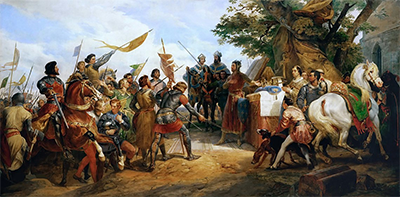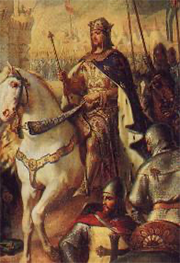The French King Philip II
Part 2: French Supremacy
When Philip returned to France, in 1191, he confronted yet another political difficulty: Richard had set aside his planned betrothal to Philip's sister Alys and married someone else. With Alys's dowry had gone the strategic territory of Vexin and the fortress of Gisors. Philip wanted them back and thought that he could get them while Richard was away. Philip thought that his chances of doing this were even better when he discovered that Richard had been kidnapped on his way home from the Holy Land. Philip enlisted Richard's younger brother, John, in the plot. Richard returned home and led his troops into battle against Philip and the French. The war dragged on for a further seven years, ending with a truce in 1199. Richard died that same year. Philip eventually had little regard for Richard's successor on the English throne, John. England and France again went to war, as John tried to reclaim some of the territories lost by his father and older brother. A further outrage, as Philip saw it, was the suspicious death of Arthur of Brittany, which removed any impediment that John had to the English throne. John proved disastrous as a commander and a strategist, and Philip considered himself victorious. Philip's wife, Isabella, had died in childbirth in 1190. Three years later, he had married Ingeborg, whose father was Denmark's King Valdemar I. The two had barely met and knew next to nothing about each other. They got along so poorly that Philip sought an annulment. He did not get it but still, in 1196, married for a third time, to Agnes of Merania; that marriage produced two children, Marie and Philip. Meanwhile, Pope Innocent III intervened and placed France under interdict, which amounted to a denial of French religious officials to administer the Christian sacraments. A year later, in 1200, Philip had his marriage to Merania annulled and accepted Ingeborg, who had been renamed Isambour, as his true wife. They had no children. 
In that same year, Philip and John agreed to the Treaty of Le Goulet, which temporarily ended the fighting between their two countries and also solidified the borders of Normandy. To cement the deal, John agreed to have his niece Blanche marry Philip's oldest son, Louis. Further disagreement in 1202 convinced Philip to abandon the treaty and seize more land in Normandy. The final French victory over England came in Flanders. England had a pair of allies in the County of Flanders and the Holy Roman Empire; together, the force numbered 9,000. Philip had 7,000 men. A number of devastating charges by French knights turned the tide at the Battle of Bouvines, on July 27, 1214. France reigned supreme. Philip largely refrained from further intrigue in the last several years of his reign. He refused to join in the Catholic Church's war on the Cathars but did serve as a negotiator in a conflict between the Duke of Burgundy and the Holy Roman Empire. What he did do, progressively, was build up the French state, both in pushing the political boundaries through diplomacy and war and in shoring up and progressing its infrastructure, centralizing the authority of the government in both the king and the capital. He oversaw the construction of a central market, Les Halles, poured money into the building of Notre-Dame, and issued a charter for the University of Paris. He also had built the Louvre (which at the time was a fortress). For all of these things, many people referred to him as Philip Augustus, after the first Roman emperor. Philip II died on July 14, 1223. Succeeding him as King of France was Louis VIII. First page > Building INfluence > Page 1, 2 |
|
Social Studies for Kids
copyright 2002–2026
David White



 Philip and Richard had found common ground during their joint struggles against Henry II. They joined
Philip and Richard had found common ground during their joint struggles against Henry II. They joined 
